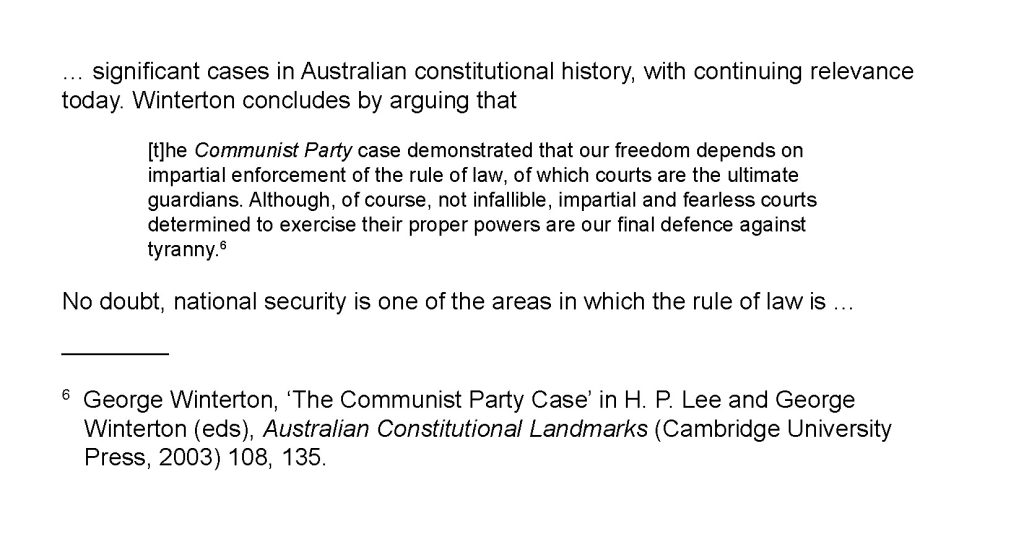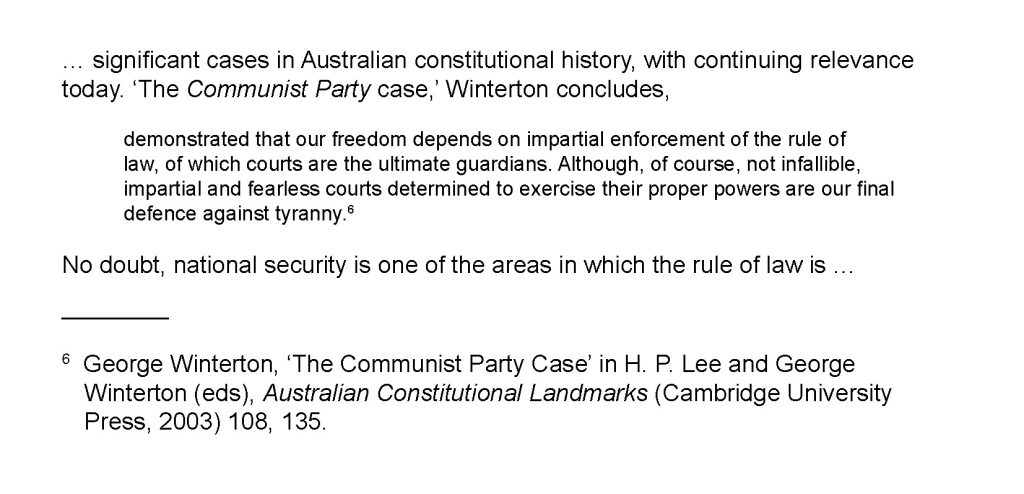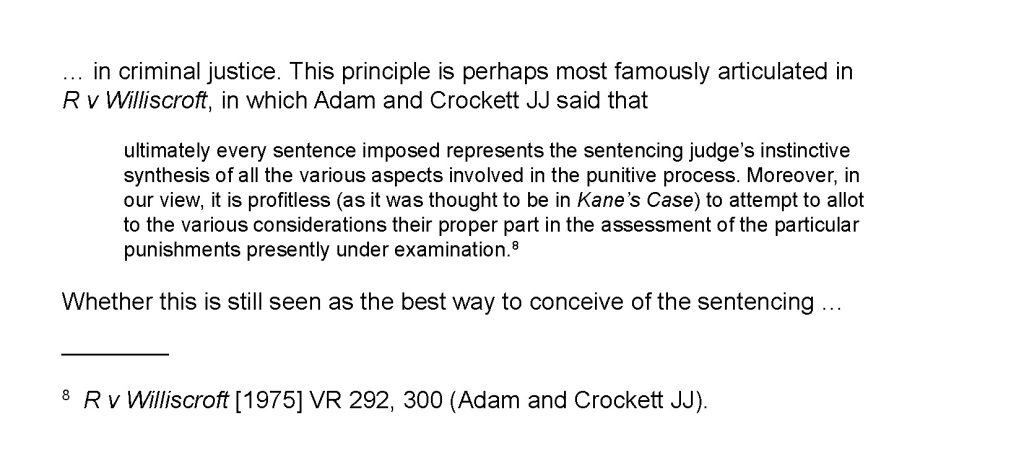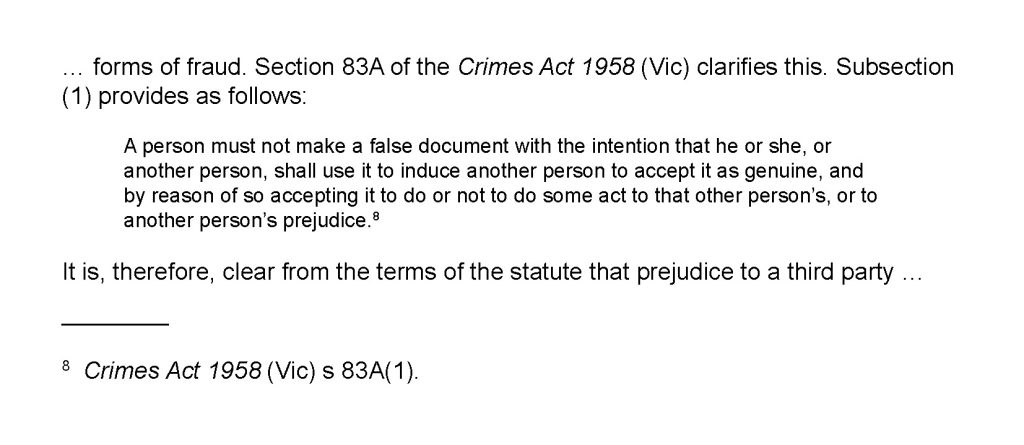4.6 Direct copying or quoting
Direct copying is where you reproduce exactly another person’s (or other persons’[1]) words. It is also known as quoting another person.
To acknowledge properly that you are directly copying, you must:
- indicate in your text (using single quotation marks) exactly which words you have taken from another person, and
- provide information about the source of those quoted words (in a footnote).
4.6.1 Quotation marks for short quotations
Where the quoted words amount to only three lines or less, then the words should be kept within the current paragraph of your text and enclosed within single quotation marks.
An example follows. (The examples in this chapter are all made up. Imagine they are extracts from student assignments.)
SHORT QUOTE
… to maintain and promote individuals’ freedom. As the American legal scholar Lon Fuller put it, ‘[t]he desideratum of clarity represents one of the most essential ingredients of legality.’8 Indeed, it is almost impossible to …
________
8 Lon L. Fuller, The Morality of Law (Yale University Press, rev ed, 1969) 63.
Note how Fuller’s words are reproduced exactly as they appear in the original source and are clearly indicated by using single quotation marks (‘ ’), which set them apart from your own words. (If you have a ‘quotation within a quotation’, use double quotation marks (“ ”) for the inner quote.)
The relevant information about the source of the quotation is contained in the footnote (here it is the eighth footnote in your assignment). The footnote tells the reader that the quoted words are from page 63 of the revised edition of Lon Fuller’s book The Morality of Law, published in 1969 by Yale University Press.
Note also how a few introductory words (‘As the American legal scholar Lon Fuller put it’) preface the actual quotation. This is preferable to going straight into reproducing Fuller’s words without saying anything to alert the reader that Fuller is about to be quoted. It is generally better to let the reader know you are about to quote someone (or that you have done so, after the quotation). It also helps to integrate their words into yours.
Finally, note also that the first letter of the quoted words from Fuller has been put into lower case and placed in square brackets. This indicates that you have altered it from upper case (in the original) in order to make the quoted words fit into the grammatical structure of your own sentence.
As a law student, you will often need to quote from cases and statutes. The method for doing so is the same as above.
QUOTE FROM A CASE
… in criminal justice. This principle is perhaps most famously articulated in R v Williscroft, in which Adam and Crockett JJ said that ‘every sentence imposed represents the sentencing judge’s instinctive synthesis of all the various aspects involved in the punitive process.’8 Whether this is still seen …
________
8 R v Williscroft [1975] VR 292, 300 (Adam and Crockett JJ).
QUOTE FROM A STATUTE
… dishonesty as an element. This is made clear in the definition of theft provided for in the Crimes Act 1958 (Vic), which states that ‘[a] person steals if he dishonestly appropriates property belonging to another with the intention of permanently depriving the other of it.’8 It is, however, left to case law …
________
8 Crimes Act 1958 (Vic) s 72.
4.6.2 Indented paragraphs for long quotations
Where the words to be quoted are longer than three lines (in your text), identify them by putting them in a distinct indented paragraph within your own paragraph. ‘Indented’ here just means the first word of each line is moved in from the left margin.
INDENTED QUOTE

Note that here the indented paragraph appears in a smaller font size and no quotation marks are used. The same sort of information about the source of the quoted words appears in a footnote.
Alternatively, quotes can be introduced in a way that splits the quoted words into a first part which appears in quotation marks in the text and a second part which appears in an indented paragraph.
SPLIT QUOTE

LONG INDENTED QUOTE

LONG QUOTE FROM A STATUTE

4.6.3 A common error: quotations without either quotation marks or an indented paragraph
If you reproduce another person’s words exactly but do not use quotation marks or an indented paragraph, then you are effectively claiming that the words are yours – and that is fundamentally misleading. An example of what not to do follows.
EXAMPLE OF BAD PRACTICE
… to maintain and promote individuals’ freedom. The desideratum of clarity represents one of the most essential ingredients of legality.8 Indeed, it is almost impossible to conceive of a legal system where such a criterion was …
________
8 Lon L. Fuller, The Morality of Law (Yale University Press, rev ed, 1969) 63.
Here it is not possible to tell which are your words and which are Fuller’s. It is not sufficient to put the footnote reference after the quoted words and leave out the quotation marks or indentations, because that does not indicate that the words are not yours. By merely putting in the footnote reference to Fuller, you are effectively only indicating, at best, that you are paraphrasing Fuller’s text or that Fuller’s text was the source of the ideas. As Fuller’s text was the source of the very words themselves, you are therefore misleading the reader. This is a common error and a good way to lose marks.
- For the rest of this chapter, read the singular as including the plural in this sort of context. ↵

